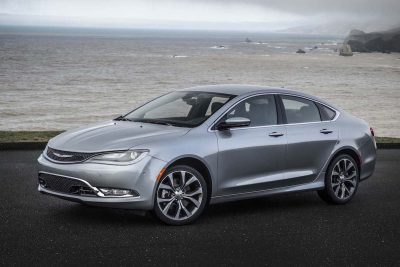 With production of the Chrysler 200 midsized sedan set to end next December, the illustrious brand will be down to just two models: the now almost elderly 300 large sedan, which shares its platform with the Dodge Charger and Challenger, and the brand new minivan Pacifica. That means the two namesake brands of Fiat Chrysler Automobiles are also its weakest volume brands in the North American market. And considering Chrysler cars are sold almost exclusively in the US and Canada, the brand doesn’t seem all that relevant anymore. That’s unfortunate for a brand which used to be one of America’s most innovative brands with a number of important technological breakthroughs to its name and which of course is credited with the creation of the minivan. However, for the past decades Chrysler has let its image crumble by selling mediocre cars and ongoing financial uncertainty under multiple owners as it has gone through a number of (near-)bankruptcies.
With production of the Chrysler 200 midsized sedan set to end next December, the illustrious brand will be down to just two models: the now almost elderly 300 large sedan, which shares its platform with the Dodge Charger and Challenger, and the brand new minivan Pacifica. That means the two namesake brands of Fiat Chrysler Automobiles are also its weakest volume brands in the North American market. And considering Chrysler cars are sold almost exclusively in the US and Canada, the brand doesn’t seem all that relevant anymore. That’s unfortunate for a brand which used to be one of America’s most innovative brands with a number of important technological breakthroughs to its name and which of course is credited with the creation of the minivan. However, for the past decades Chrysler has let its image crumble by selling mediocre cars and ongoing financial uncertainty under multiple owners as it has gone through a number of (near-)bankruptcies.
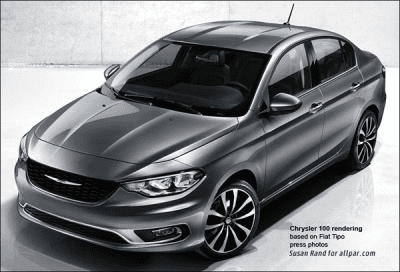 While Jeep has made an impressive revival in the past few years, Chrysler doesn’t seem destined to make a similar transformation if you look at the brand’s product planning for the near future. The 200 will be axed at the end of 2016 as years of mediocrity has reduced its prospective customer pool to daily rental fleets and buyers with employee discount, even though the last generation was probably the most competitive midsized sedan Chrysler has had in decades. Plans for a semi-premium compact sedan in the spirit of the Buick Verano and based on the Dodge Dart have understandably been scrapped now that the Dart is dead and the Verano will be killed as well. The future of the 300 is still uncertain, as a decision to replace the current model hasn’t been made yet, which means it won’t arrive before 2020, if at all.
While Jeep has made an impressive revival in the past few years, Chrysler doesn’t seem destined to make a similar transformation if you look at the brand’s product planning for the near future. The 200 will be axed at the end of 2016 as years of mediocrity has reduced its prospective customer pool to daily rental fleets and buyers with employee discount, even though the last generation was probably the most competitive midsized sedan Chrysler has had in decades. Plans for a semi-premium compact sedan in the spirit of the Buick Verano and based on the Dodge Dart have understandably been scrapped now that the Dart is dead and the Verano will be killed as well. The future of the 300 is still uncertain, as a decision to replace the current model hasn’t been made yet, which means it won’t arrive before 2020, if at all.
If you’ve followed FCA this year, you’ll know that the company is all but abandoning cars and is betting big on more profitable SUVs, pick-up trucks and crossovers in the North American market, so it shouldn’t come as a surprise there are two three-row crossovers in the product pipeline for the Chrysler brand as well. That’s not a bad strategy as long as gas prices remain low and these models add value to existing offerings in the market and are marketed right. 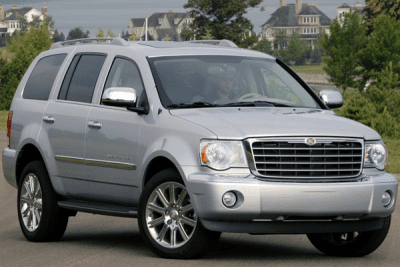 Those requirements are exactly where Chrysler has faltered with crossovers in the past. Do you remember the Chrysler Aspen? No? Not surprising as the Aspen was a rebadged Dodge Durango with added chrome and a higher price tag. It was built from 2006 to 2009 and less than 65,000 units were sold in the US in those four years, less than the Durango sold in 2006 alone. Then there’s the first generation Pacifica, produced from 2003 to 2007 and which wasn’t an outright failure in sales volume with about 475,000 units sold. However, it suffered from a reputation of substandard quality and was positioned wrongly in the market so it never hit the projected 100,000 annual sales. So much for a brief history lesson of Chrysler’s previous attempts at crossovers, now let’s take a look at the projected future:
Those requirements are exactly where Chrysler has faltered with crossovers in the past. Do you remember the Chrysler Aspen? No? Not surprising as the Aspen was a rebadged Dodge Durango with added chrome and a higher price tag. It was built from 2006 to 2009 and less than 65,000 units were sold in the US in those four years, less than the Durango sold in 2006 alone. Then there’s the first generation Pacifica, produced from 2003 to 2007 and which wasn’t an outright failure in sales volume with about 475,000 units sold. However, it suffered from a reputation of substandard quality and was positioned wrongly in the market so it never hit the projected 100,000 annual sales. So much for a brief history lesson of Chrysler’s previous attempts at crossovers, now let’s take a look at the projected future:
A midsized crossover is planned for 2019, which will share the front-wheel drive platform and many components with the Jeep Cherokee. In itself this is exactly the kind of model the market is waiting for, but remember that FCA already has such a crossover in its range: the Dodge Journey, which would move to Alfa Romeo’s rear-wheel drive Giorgio platform in 2018. The added value of a front-wheel drive Chrysler next to this Journey is not exactly clear to me, considering a Chrysler would usually be positioned higher in the market than a Dodge, while this one will use a cheaper platform.
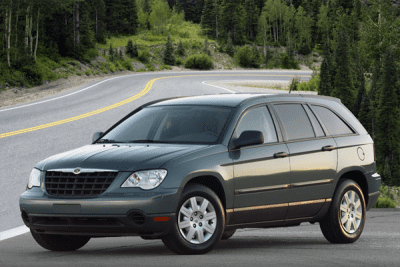 In addition, Chrysler is planning for a 2018 launch of a full-sized all-wheel drive crossover on the platform of the new Pacifica in 2018 but without the sliding doors and innovative Stow ‘n Go seats. That means it’ll be a less practical version of the Pacifica, following the trend that minivans are unhip and crossovers are hot. This looks like a deja vu from a decade ago, when the Pacifica from back then also didn’t have a clear positioning: it was marketed as an alternative to a minivan but was too expensive and impractical for those buyers, while SUV buyers considered it not tough and capable enough. Chrysler risks making the same mistake again: those who want a practical car and don’t car about image are better off with the Pacifica, while those who prefer the looks of a crossover or need the capability of an SUV are likely to rather drive a Jeep than a Chrysler.
In addition, Chrysler is planning for a 2018 launch of a full-sized all-wheel drive crossover on the platform of the new Pacifica in 2018 but without the sliding doors and innovative Stow ‘n Go seats. That means it’ll be a less practical version of the Pacifica, following the trend that minivans are unhip and crossovers are hot. This looks like a deja vu from a decade ago, when the Pacifica from back then also didn’t have a clear positioning: it was marketed as an alternative to a minivan but was too expensive and impractical for those buyers, while SUV buyers considered it not tough and capable enough. Chrysler risks making the same mistake again: those who want a practical car and don’t car about image are better off with the Pacifica, while those who prefer the looks of a crossover or need the capability of an SUV are likely to rather drive a Jeep than a Chrysler.
My point is that I don’t see the added value of these two models within the existing FCA line-up. They’ll always be the less successful sibling of another model, which hurts the brand more than it helps. So, what’s the alternative for Chrysler: quietly kill the brand off and only continue the Pacifica as a Dodge (please don’t rename it Caravan)? That shouldn’t be necessary if FCA would only invest in the brand and its image, most importantly to be clear about what Chrysler stands for, as that’s what makes a strong brand. Look at Jeep, one of the most recognizable automotive brands anywhere in the world and one of the most successful US global export brands, next to McDonalds and Coca-Cola. No wonder FCA is investing heavily into expanding Jeep’s model range and tapping into new markets by spreading production to key growth markets like Brazil, China and India. I’m not saying the same is possible for Chrysler in the short or medium term, but if it’s going to remain a North America-only brand (possibly adding Europe back in), then why not revive its former technology-leading image?
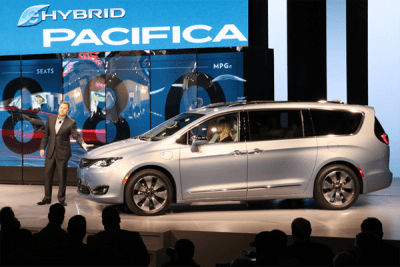 Presently, FCA is hopelessly behind its competitors in the field of electrification and future mobility concepts, as Marchionne’s short-sighted vision sees no short-term profit in those developments while he only sees the big profit margins of SUVs, pickups and crossovers as long as oil prices remain low. But he should spread his chances and let Jeep, Ram and Dodge reign in those markets while turning Chrysler into the innovative brand of the group, bringing down the Corporate Average Fuel Efficiency figure as a secundary benefit. They’re off to decent start with the upcoming Pacifica PHEV and a possible tie-up with Google would help too. I think this is an opportunity to differentiate themselves from existing offerings: combine the popular bodystyle of the present with the powertrain of the future: electrified crossovers. At the moment, there are only a few Plug-in SUVs in the luxury segment, but I think GM really missed an opportunity to really make a move against Tesla when the Bolt was launched as an MPV instead of a crossover. Similarly, I don’t understand why Kia only plans to make hybrid and plug-in hybrid versions of the Niro crossover, based on the same platform as the Hyundai Ioniq, which has full EV capability. So if FCA wants its namesake brand to have a prosperous future, I’d suggest Marchionne to look beyond the internal combustion engine and let Chrysler be an innovator again.
Presently, FCA is hopelessly behind its competitors in the field of electrification and future mobility concepts, as Marchionne’s short-sighted vision sees no short-term profit in those developments while he only sees the big profit margins of SUVs, pickups and crossovers as long as oil prices remain low. But he should spread his chances and let Jeep, Ram and Dodge reign in those markets while turning Chrysler into the innovative brand of the group, bringing down the Corporate Average Fuel Efficiency figure as a secundary benefit. They’re off to decent start with the upcoming Pacifica PHEV and a possible tie-up with Google would help too. I think this is an opportunity to differentiate themselves from existing offerings: combine the popular bodystyle of the present with the powertrain of the future: electrified crossovers. At the moment, there are only a few Plug-in SUVs in the luxury segment, but I think GM really missed an opportunity to really make a move against Tesla when the Bolt was launched as an MPV instead of a crossover. Similarly, I don’t understand why Kia only plans to make hybrid and plug-in hybrid versions of the Niro crossover, based on the same platform as the Hyundai Ioniq, which has full EV capability. So if FCA wants its namesake brand to have a prosperous future, I’d suggest Marchionne to look beyond the internal combustion engine and let Chrysler be an innovator again.
However, here’s the problem: Fiat Chrysler Automobiles currently already is the automaker with the worst cash position of all, and is commited to investing all of its available credit to restore Alfa Romeo and Maserati as successful premium brands and to expand their North American capacity for the production of pick-up trucks and SUVs at the expense of its car lineup. Tell me: if it was your money, what would you invest it in?









